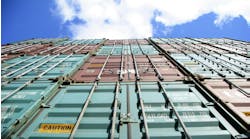Smart Strategies for Logistics Cost Optimization
The graphic illustration of any global logistics operation, with its complex web of vendors, warehouses, distribution centers, service operations, transportation routes and hubs, can reveal an intricate map where individual costs are difficult to separate and understand. In a world where logistical expenses typically comprise up to four to five percent of total costs for a manufacturing firm, the increasing complexity of the global supply chain applies increased pressure on margins.
Enterprises usually implement transformation technology solutions or partner with a third-party provider to manage costs. Yet, many organizations find themselves falling short of their savings goals. Why?
Growth is Good, But...
As supply chains have become more global, the logistics network has been augmented with new routes and locations. Each new link in the supply chain brings its own local complexities regarding the availability of logistics assets, local laws and regulations, and infrastructure, among others.
Other factors offer increased challenges. Finding appropriate service providers, for example, is a more complicated process than it used to be. Plus, manufacturers need to conduct periodic risk assessments to ensure that natural disasters, political developments and other factors beyond their control are not looming as an incipient threat to production and fulfillment.
A Three-Pronged Weapon Against Complexity
Most organizations try to tame complex supply chains by deploying expensive technology tools, hiring consultants for business process re-engineering, or, more recently, deploying exotic analytics frameworks.
Alone, none of these solutions can produce the type of savings needed to outcompete in this new, more complex and more competitive economy. What is required is a smart mix of process, analytics and technology to simplify the logistics networks, mitigate logistics risk and optimize the associated costs. We call this a three-pronged holistic approach:
1. Process Design and Development
“Smarter” processes are the key to more cost-effective operations. This means that organizations serious about creating more streamlined and more effective networks need to look at their operations in detail before beginning any redesign of logistics processes. This involves deep analysis to:
- Develop a granular view of the process activities (carrier identification, logistics spend analysis, etc.);
- Define key performance indicators such as asset utilization and median loading time and then link them to the business outcome of particular costs;
- Identify the drivers of outstanding cost performance; for instance, building multiple “what if” scenarios for networks to estimate impact on costs;
- Benchmark against industry standards for cost management in order to understand current performance gaps;
- Implement best practices to improve costs and sustain process performance.
Businesses that take the time to do a detailed and thorough analysis of operations from end-to-end and across the global footprint can yield deep insights that will support a new, more effective—and less costly—logistics network. By analyzing current processes, organizations can identify process steps where cost leakages occur. Some process steps may add little or no value; others may need enabling technology tools in order to maximize efficiency and increase cost effectiveness.
Here are a few real-world examples from deep analysis:
- After a pharmaceutical major conducted a thorough analysis of logistics processes for an acquired company and standardized processes, it was able to identify cost optimization opportunities of 25 percent.
- A chemicals leader achieved five to seven percent cost savings through revisiting processes related to shipping frequency, reassignment of supplier-warehouse combinations and set up of ‘milk-runs.’
- A life sciences major identified 13 percent potential baseline freight cost savings by analyzing logistics management processes and finding opportunities to increase consolidation of shipments.
2. Analytics
Leveraging analytics frameworks for analyzing cost performance is a powerful driver for lowering overall costs. Network design analysis, route/mode selection, and logistics spend analysis are a few of the areas where analytics can be leveraged. For businesses to be most effective, they should use tools that can simulate different scenarios of various parameters such as lanes, routes, infrastructure constraints, customs clearance practices, logistics modes and asset utilization. With this data in hand, the logistics organization can better understand the impact of costs from various combinations and design their networks accordingly.
A number of tools are currently available to analyze costs, including network optimization, carrier sourcing and freight lane analysis. Selection of a logistics analytics tool should be based on: 1) its ability to rapidly study various “what if” scenarios in order to make processes more effective in achieving the business outcomes of cost, and 2) its ability to identify risks and assess the cost impact of such risks on logistics networks.
For instance, one chemical manufacturer created and analyzed multiple scenarios for distribution centers, an optimization effort that generated savings of 17 percent. Another manufacturer leveraged analysis to identify recoverable costs from suppliers, then set up detailed reports and dashboards to increase visibility into various logistics costs components.
3. Enabling Technology
Technology in the absence of deep understanding of processes may not be effective in optimizing logistics costs. Simply upgrading the software, without better processes, may actually make the problem worse as employees try to make old processes work with new tools rather than using the tools to support more effective standardized global processes. The selection of technology therefore must be driven by the tool’s potential to:
- Simplify processes (reduce hand-offs, approvals, automate process steps);
- Expedite exception handling (reduce the number of exceptions, auto-resolve commonly occurring exceptions);
- Reduce systems/applications complexity (standard interface, fewer middleware applications required, better workflows).
New Challenges, New Approach
Global logistics networks are an integrated, evolving creation. If a business wants to create a best-in-class network, it needs to develop a deep understanding of the risks and costs associated with multiple logistics partners, geographies, products and technology tools. At the same time, an organization cannot depend on process or technology alone to provide the end-to-end improvements that drive true cost savings.
Consistently reducing and optimizing costs without increasing logistics risk can only be achieved by intelligently combining industry-specific analytics frameworks, the right technology tools and logistics processes engineered for effectiveness as well as greater efficiency.
Suresh Iyer is vice president and global practice leader for Engineering & Supply Chain Services at Genpact, where he is responsible for strategy development, new capability acquisition and execution. Advait Rahalkar is assistant vice president with the Supply Chain Practice at Genpact, where he builds solutions for supply chain management.




